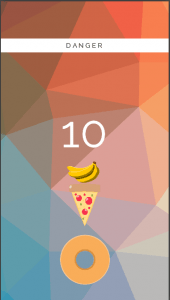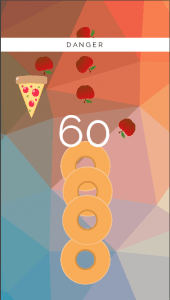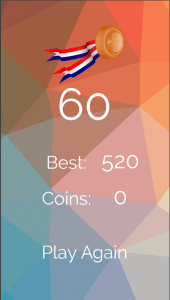In most video games, you play as a hero trying to achieve an objective while defeating some enemies. Take Space Invaders, for example. In the classic arcade game, you play as a pilot ship trying to destroy evil alien aircraft. It’s obvious that you need to defend what’s right and take down what’s wrong. For my project, I wanted to spin that concept around. In my game, Donut Defender, you play as a pizza slice and your goal is to block and deflect any delicious healthy fruits that fall down the screen. By the way, there is a donut at the bottom of the screen and if a fruit touches it, it will replicate. If enough donuts fill up your screen, you lose the game. Now you might be wondering, shouldn’t I have made a game where the objective was to defend fruits and extinguish donuts and pizzas? Well my goal was intentional. I wanted this game to be a subtle reflection on how America values unhealthy foods. According to data from the federal government, breads, sugary drinks, and pizza are among Americans’ top sources of calories. They are also made from seven crops that are greatly subsidized by the federal government (corn, soybeans, wheat, rice, sorghum, milk, meat). This means that junk foods can not only be made in great quantity, but also for a cheap price. The real kicker is that the government gave $170 billion in agricultural subsidiaries between 1995 and 2010 in order to produce these goods (O’Connor 1). If we live in a society that pushes for so many healthy eating initiatives, how come the money is going to the foods that aren’t so healthy?
Now that I’ve explained my game’s hidden agenda, let me go into detail about the game’s mechanics. Though it is currently a computer game, it is intended to be played on mobile devices. You would use your finger to drag the pizza icon and deflect incoming fruits. For each fruit you deflect, you earn 10-30 points. Apples give you 10, pears give you 20, and bananas 30. My original design had it so that every time a donut replicates, the player would earn more points. This gave the player the incentive to spawn some donuts, so that they would earn more points by the end of the game. I’m still unsure if I want this to be the case and further play testing might help me come to a conclusion. There are also coins that randomly fly across the screen every now and then. If the player were to risk moving to a different position and acquire the coins, they will eventually be able to buy different donut skins. I created five skins so far, but if I further develop the game, I could create more. Overall, I wanted this game to be an easygoing experience that also builds your finger reflexes (and maybe make you think about the FDA).
O’Connor, Anahad. “How the Government Supports Your Junk Food Habit.” The New York Times, The New York Times, 19 July 2016, well.blogs.nytimes.com/2016/07/19/how-the-government-supports-your-junk-food-habit/.



